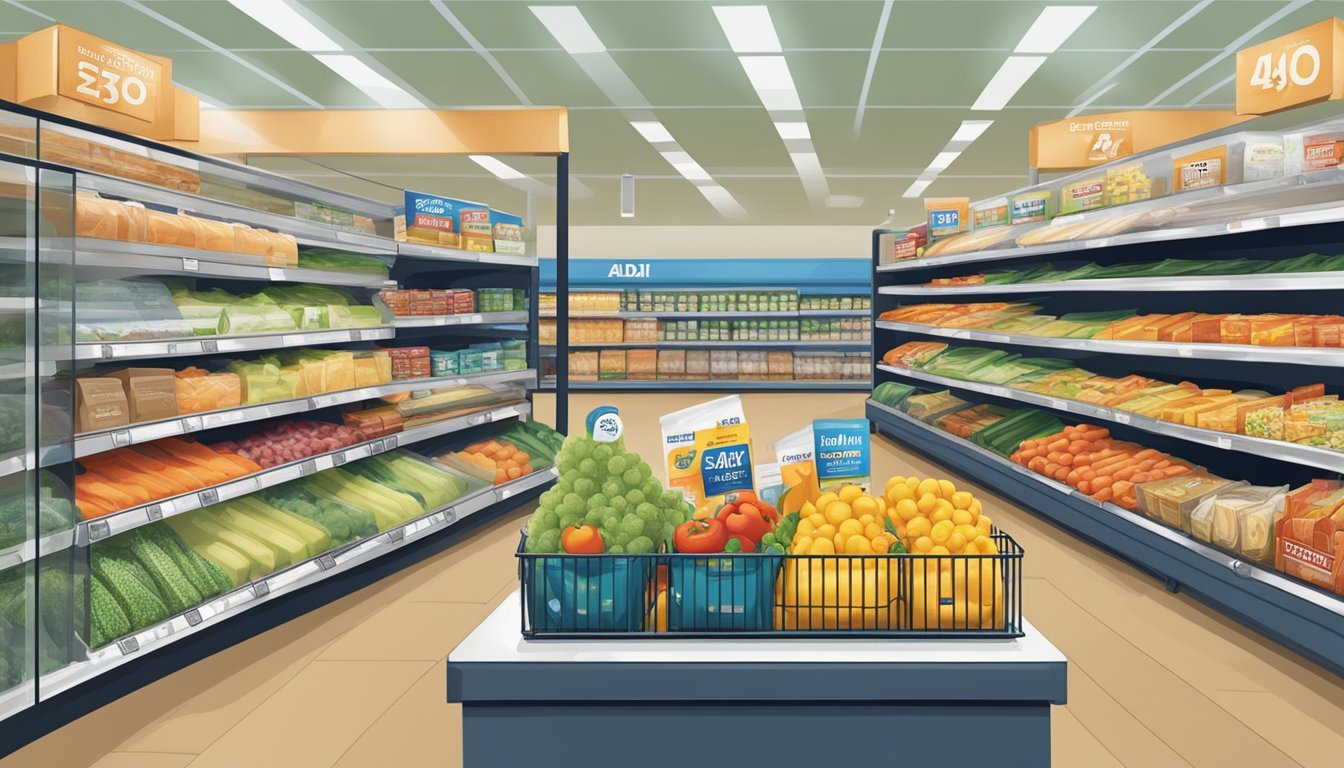Is Aldi Cheaper Than Safeway?
Comparing Grocery Prices and Value
Part of Our Grocery Store Guide with Details on Aldi Prices and Safeway Prices
When it comes to grocery shopping, price is often a key consideration for consumers. With a variety of chains to choose from, shoppers are always looking for the store that offers the best value for their money. Aldi, a German discount supermarket chain, has consistently been recognized for its low prices. Its business model emphasizes efficiency, minimalistic store layouts, and a focus on private labels, which contribute to cost savings for customers.
On the other hand, Safeway, a well-established American grocery store, offers a wider selection of brands and a different shopping experience, which might come with a different pricing structure. While Safeway provides promotional deals and a loyalty program, its prices are often perceived to be higher compared to discount stores like Aldi. However, the convenience of location and the availability of certain specialty or regional items can influence a shopper's choice of store beyond pricing alone.
Comparing Aldi and Safeway requires an examination beyond mere price tags. One must consider factors such as product quality, store location, shopping experience, and the variety of goods offered. Shoppers' preferences vary widely, and while Aldi might be cheaper for basic essentials and private label goods, Safeway might hold the edge in selection and convenience for some consumers.
Overview of Grocery Shopping Dynamics
When discussing the affordability of grocery shopping, it's essential to examine both the market structure of grocery stores and the various elements influencing the prices of groceries.
Grocery Store Market Landscape
The grocery industry has a diverse array of players, ranging from traditional supermarket chains like Safeway and Kroger to discount stores such as Aldi. This sector also includes warehouse clubs like Costco, high-end retailers like Whole Foods, and niche markets such as Trader Joe’s and Sprouts Farmers Market. Additionally, general retailers Walmart and Target have significant grocery divisions, further intensifying market competition.
Supermarket Chains: These are the conventional grocery stores that carry a wide variety of food and household products.
Discount Stores: Known for their lower prices, usually achieved by carrying private labels and bulk packaging.
Warehouse Clubs: Membership-based retailers offering products in large quantities at discounted prices.
Specialty Stores: Grocery chains like Trader Joe’s or Sprouts Farmers Market focusing on unique selections and often organic products.
Price Factors in Grocery Shopping
The price points set by grocery stores are influenced by several factors which ultimately affect the savings a consumer can make on their grocery bills. These factors include:
Volume of Sales: Larger retailers may offer lower prices due to economies of scale.
Private Labels: Stores like Aldi save customers money by offering a majority of in-house brands.
Location: Geographic location can affect operational costs and, subsequently, prices.
Promotions: Regular discounts or loyalty programs can lead to substantial savings.
Product Range: Some stores, such as Whole Foods, carry specialty items, which tend to be priced higher.
The battle for saving on the budget often leads consumers to compare average prices between stores to determine the most cost-effective options for their needs.
Comparing Aldi and Safeway
This section examines the differences between Aldi and Safeway in terms of their business models, market position, pricing strategies, consumer experiences, and the availability of organic products.
Aldi's Business Model and Pricing
Aldi operates on a no-frills, low-expense business model that allows it to offer products at significantly lower prices compared to traditional supermarkets. By stocking shelves with mostly generic staples and operating smaller stores, the cost savings are passed on to consumers. Aldi's emphasis on in-house brands contributes to their reputation for value, offering limited selections with emphasis on quality at a reduced price.
Safeway's Position in the Market
Safeway is known for its wide variety of national brands as well as its own store brands. As a traditional grocery chain, Safeway places a strong emphasis on providing high-quality produce and a larger array of products. This, combined with a focus on customer service and shopping atmosphere, tends to result in higher pricing compared to discount stores. Safeway is often perceived as offering a more premium shopping experience.
Price Comparison Methodology
Conducting a price comparison between Aldi and Safeway entails evaluating a standard basket of goods. Researchers typically select a range of common items and compare the total cost at each store. Studies often account for regular prices as well as sales and promotions to provide a well-rounded view of potential savings. Care is taken to adjust for differences in brand and product size for an accurate comparison.
Real-Consumer Experiences
Consumer reviews and ratings reflect real shopping experiences, providing insights into value for money. Research has indicated that consumers have found Aldi to be more affordable than Safeway on a per-item basis. However, customer preferences can vary with some finding Safeway's higher price points acceptable for its perceived quality and shopping environment.
Organic and Health-Focused Products
Both Aldi and Safeway offer selections of organic produce and health-focused products, with Safeway traditionally offering a broader range for health-conscious consumers. While Aldi has been expanding its organic offerings, including partnering with brands like Whole Foods, Safeway has been a long-standing choice for customers seeking high-quality produce and special dietary products, which influences the comparison of their grocery bills.
Specific Product Price Analysis
When comparing Aldi to Safeway, one can gauge cost differences by examining specific categories of grocery items. This analysis will focus on key areas of the grocery shopping experience to provide a snapshot of where consumers might find better deals.
Meat and Produce
Aldi often has more competitive prices on meat and fresh produce compared to Safeway. For example, chicken breast at Aldi can be found at prices that are sometimes significantly lower than Safeway's offerings. Similarly, Aldi's selection of veggies and fruit like bananas usually comes with a smaller price tag while still offering quality.
Dairy and Eggs
In the dairy section, Aldi generally undercuts Safeway on milk and butter. Aldi's prices for eggs are also frequently lower, potentially offering savings for consumers who prioritize dairy in their diet.
Milk (gallon): Aldi - $2.49, Safeway - $3.19
Butter (1 lb.): Aldi - $2.95, Safeway - $3.99
Eggs (dozen): Aldi - $1.15, Safeway - $1.89
Pantry Staples
Staple pantry items such as rice, pasta, cereal, and black beans are areas where Aldi typically offers more appealing prices compared to Safeway. Consumers looking to stock their pantries might find Aldi to be a more economical option.
Rice (white, 1 lb.): Aldi - $0.89, Safeway - $1.29
Pasta (16 oz.): Aldi - $0.79, Safeway - $1.00
Cereal (generic brand, 18 oz.): Aldi - $1.19, Safeway - $2.49
Black beans (canned, 15 oz.): Aldi - $0.79, Safeway - $0.99
Other Common Grocery Items
For other common grocery items such as loaves of bread and canned corn, Aldi's pricing tends to be lower. This is indicative of Aldi's general pricing strategy, which focuses on affordability across various grocery categories.
Bread (loaf, white): Aldi - $0.85, Safeway - $1.19
Canned corn (15 oz.): Aldi - $0.49, Safeway - $0.89
By providing a variety of goods at lower prices, Aldi is often perceived as the more affordable option for shoppers looking to save on their grocery bills.
Cost-Saving Tips for Shoppers
When evaluating grocery bills, shoppers often look for strategies to stretch their budget further. The following subsections offer specific tips on how to save money at Aldi and maximize value at Safeway, as well as insights into comparing shopping carts at both retailers.
Strategies for Saving at Aldi
Buy Aldi exclusive brands: A significant portion of Aldi's inventory consists of its own private labels, which tend to be more affordable than national brands.
Take advantage of Aldi Finds: Special buys available for a limited time often present deep discounts on a wide range of products.
At Aldi, shoppers should focus on their exclusive brands, which are designed to be less expensive. These products can lead to substantial savings on one's grocery budget as they generally undercut competitors' prices.
Maximizing Value at Safeway
Loyalty programs: Joining the Safeway loyalty program can unlock various discounts and special offers tailored to shopping habits.
Weekly ads and coupons: Regularly checking Safeway's flyers for sales and clipping coupons can lead to lower prices on a shopper's favorite items.
Shoppers at Safeway can make the most of their purchases by engaging with the store's loyalty program. This program is built to foster savings opportunities through discounts and promotions exclusive to members.
Comparing Shopping Carts
Cost comparison: A head-to-head comparison of identical or similar items at both stores can reveal which offers the lowest prices.
Calculate savings: For families spending about $250 per week, finding stores with lower average prices like Aldi can lead to significant annual savings.
When comparing shopping carts between Aldi and Safeway, consumers should consider both the price point and the quantity of items. Aldi's streamlined selection can lead to a cheaper grocery bill, while Safeway's higher-priced items might be offset by coupon savings and loyalty discounts.
The Impact of Location and Convenience
The convenience of a grocery store's location and the variety of products available can significantly influence consumer choices between Aldi and Safeway.
Store Proximity and Product Availability
Consumers choose a grocery store not only for the prices but also for how close the store is to their home or work. Aldi may offer lower prices on many items, but Safeway stores could be more conveniently located for some shoppers. Additionally, product availability can vary, with Safeway typically offering a wider variety of brands and specialty items compared to Aldi's mainly private-label merchandise.
Grocery Delivery and Online Shopping
Online shopping options can offset the inconvenience of greater distance. Aldi has expanded its grocery delivery services through partnerships with companies like Instacart. On the other hand, Safeway, with its own delivery service and options through third-party providers like Amazon Prime, offers various delivery solutions to accommodate the customers' needs. Grocery delivery options significantly enhance consumer convenience, making store location less of a deciding factor.
Local Price Variances
Prices at both Aldi and Safeway can fluctuate based on the surveyed area consumers reside in. Safeway's prices may be higher due to factors such as store location in higher-cost regions or offering a broader array of products. In contrast, Aldi maintains its low-price appeal largely due to its efficient business model, even as both stores face location-specific operational costs that can affect pricing.
Brand Loyalty and Store Preference
The choice of grocery store is often a delicate balance of cost, quality, and loyalty. Consumers weigh their preference for store brands against the allure of national names, and loyalty programs can tip the scales in favor of one retailer over another.
Understanding Consumer Preferences
Consumers tend to have varied priorities when selecting a grocery store. For some, the decision may hinge on pricing, while others prioritize the selection or quality of products. In comparing Aldi and Safeway, it's noted that Aldi often operates on a low-cost, private label-focused model. This may appeal to budget-conscious families. Safeway, with a broader assortment of name-brand products, could attract those with specific brand loyalties or preferences for national brands.
Comparing Store Brands to National Brands
When it comes to Aldi, their shelves are predominantly stocked with store brands, which can offer significant savings without compromising on quality. Aldi's store brands have been known to be more affordable than name-brand equivalents at other retailers, including Safeway. Safeway, on the other hand, carries a mixture of national brands and their own private labels, providing a wider choice that caters to various consumer preferences.
Retailer Loyalty Programs
Loyalty programs play a crucial role in fostering customer retention and encouraging repeat business. Safeway offers a loyalty program that rewards consumers with discounts, personalized deals, and fuel points, potentially offsetting the higher prices of name-brand products. Aldi, traditionally low-frills and discount-driven, does not offer a conventional loyalty program. Instead, they focus on keeping prices universally low, banking on the strategy that consistent savings can drive consumer loyalty just as effectively.
Final Considerations and Summary
In comparing Aldi and Safeway, it has been observed that Aldi tends to offer lower prices, primarily due to its focus on private labels and cost-saving strategies. This section reflects on the implications of this price discrepancy for consumers and the grocery industry, as well as the potential future pricing trends.
Summary of Findings
Aldi's pricing strategy is based on an extensive range of private label products, which contributes to its lower price points in comparison to Safeway. The price difference can be significant, potentially affecting consumer choices and spending patterns. Aldi's approach to cost-saving—minimalist store design and product range—allows for these savings to be passed on to their customers.
Implications for the Grocery Industry
The competitive pricing offered by Aldi may prompt other supermarket chains, such as Safeway, to evaluate and potentially adjust their strategies. Retailers face the challenge of balancing product quality and variety with competitive pricing to maintain customer loyalty. Further, the presence of a cost-effective option like Aldi in the market puts pressure on traditional grocery chains to innovative in areas such as supply chain efficiency and in-store experience.
Future Outlook for Pricing Trends
As retailers continue to evolve, Aldi's model may influence a broader industry trend towards lower prices and increased value for the consumer. However, factors such as inflation, supply chain disruptions, and changing consumer preferences could influence pricing trends. Grocery stores like Aldi and Safeway may also adopt more nuanced strategies that cater to both price-sensitive customers and those looking for specialty products or a more conventional shopping experience.
Additional Resources
When considering whether Aldi is cheaper than Safeway, various resources can provide in-depth information, financial assistance options, and product insights. These resources can help consumers make informed decisions about their grocery budget.
Academic and Market Research
Researchers often conduct studies comparing pricing at different grocery stores. Consumers can look for articles and papers in journals that focus on consumer behavior and retail analysis. For example, examining the research from universities such as the University of Michigan can shed light on why stores like Aldi may offer lower prices, often due to their business models that focus on cost-saving strategies.
Financial Assistance Programs for Groceries
For those looking to stretch their grocery budget further, various financial assistance programs offer discounts or aid. Consumers can consult with local government social service agencies to understand the eligibility criteria for programs like the Supplemental Nutrition Assistance Program (SNAP). Additionally, some grocery stores, including Aldi and Safeway, may participate in special discount events or offer store-specific loyalty programs.
Product Reviews and Recommendations
Websites like Consumerpedia can be a source for ratings and reviews, providing insights into product quality and value for money. For a more interactive approach, podcasts dedicated to budget shopping and grocery trends often feature episodes that compare stores like Aldi and Safeway. Listening to these podcasts can provide firsthand accounts and recommendations to help consumers save money.
By exploring these resources, consumers can gather comprehensive information regarding prices, discounts, and offerings between Aldi and Safeway to determine which store aligns best with their budget and shopping preferences.







